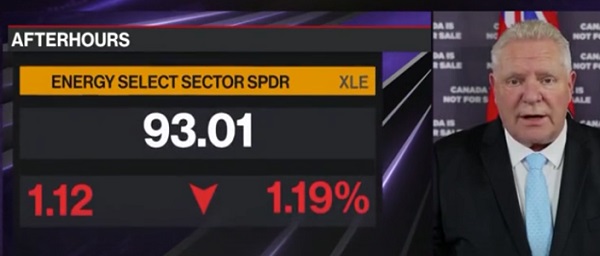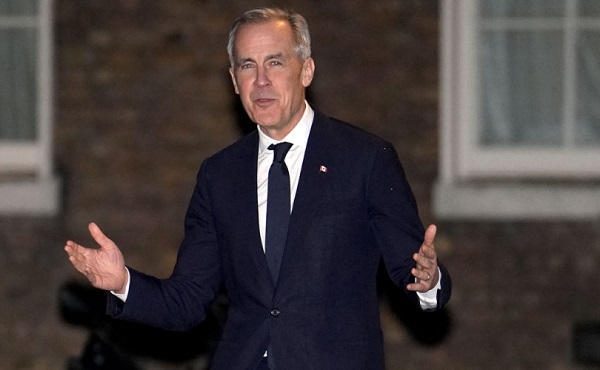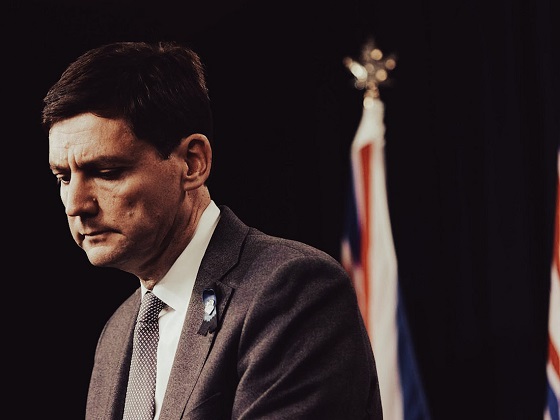Alberta
“The River” water feature chosen by Albertans for the Legislature Grounds
Albertans choose water feature at legislature grounds
Work is underway at the legislature grounds to restore the existing pools and install a new water feature.
Input from nearly 4,000 Albertans in a recent Government of Alberta survey has determined the design of a new water feature for the legislature grounds.
Albertans overwhelmingly supported the design concept “River,” which received more than 65 per cent of the vote.
Here is the announcement from Deputy Premier Nathan Neudorf and Speaker Nathan Cooper:
The survey ran Jan. 12-27 and gave Albertans the chance to choose their favourite of three proposed designs for a new water feature that will be installed at the north plaza of the legislature grounds, replacing the deteriorated terraced wading pools.
Of the other two designs, “Aurora” received 17.1 per cent of the votes followed closely by “Strata” with 17 per cent.
“Thank you to everyone who helped us choose the River design. Nearly 4,000 Albertans responded to the project survey. The feedback and suggestions provided have been crucial in determining the look, feel and future use of this part of our legislature grounds. Your input helps ensure that Alberta’s legislature and grounds will continue to be a destination for Albertans and visitors alike.”
“Alberta’s legislature and grounds are a gathering place for Albertans and visitors from all walks of life. Thanks to this project, the north plaza will have a great new gathering place to enjoy in the summer months. Thank you so much to everyone who took time to submit their feedback. I cannot wait until the new features open in 2024!”
Removing the terraced wading pools and installing the new River area will be part of a larger project to refurbish the water features and improve the north plaza.
Project work at the north plaza is underway and is expected to be completed in 2024.
Quick facts
- The dome fountain and reflecting and wading pools have been closed to the public since 2020 due to the COVID-19 pandemic and mechanical system and public safety issues.
- $20 million is being invested into renewing or replacing the water features and walkways on the Alberta legislature grounds:
- $10 million through the Alberta government’s Budget 2022 Capital Plan
- $10 million through the Investing in Canada Infrastructure Program (ICIP), with $8 million from the Government of Canada and $2 million from the Alberta government
- The Jan. 12- 27 survey posted to alberta.ca received 3,663 responses to the question: Do you have a preferred North Plaza design concept?
- River – 2,413 votes
- Aurora – 628 votes
- Strata – 622 votes
- Reasons Albertans chose the River concept include:
- tranquility
- natural materials
- use of planting/landscape for colour
- more green space, less concrete
- shade provided by trees
- continuous flowing water
- maintained site lines of legislature building
- accessible water animation
- Repairs will be made to the reflecting pool and ornamental dome fountain, replacing piping, updating mechanical and filtration systems, and fixing leaks. The cracked and weathered concrete decking and walkways around all the water features will be replaced. The water barrier on top of the 97 Avenue underpass will also be replaced with a new membrane.
Alberta
Big win for Alberta and Canada: Statement from Premier Smith

Premier Danielle Smith issued the following statement on the April 2, 2025 U.S. tariff announcement:
“Today was an important win for Canada and Alberta, as it appears the United States has decided to uphold the majority of the free trade agreement (CUSMA) between our two nations. It also appears this will continue to be the case until after the Canadian federal election has concluded and the newly elected Canadian government is able to renegotiate CUSMA with the U.S. administration.
“This is precisely what I have been advocating for from the U.S. administration for months.
“It means that the majority of goods sold into the United States from Canada will have no tariffs applied to them, including zero per cent tariffs on energy, minerals, agricultural products, uranium, seafood, potash and host of other Canadian goods.
“There is still work to be done, of course. Unfortunately, tariffs previously announced by the United States on Canadian automobiles, steel and aluminum have not been removed. The efforts of premiers and the federal government should therefore shift towards removing or significantly reducing these remaining tariffs as we go forward and ensuring affected workers across Canada are generously supported until the situation is resolved.
“I again call on all involved in our national advocacy efforts to focus on diplomacy and persuasion while avoiding unnecessary escalation. Clearly, this strategy has been the most effective to this point.
“As it appears the worst of this tariff dispute is behind us (though there is still work to be done), it is my sincere hope that we, as Canadians, can abandon the disastrous policies that have made Canada vulnerable to and overly dependent on the United States, fast-track national resource corridors, get out of the way of provincial resource development and turn our country into an independent economic juggernaut and energy superpower.”
Alberta
Energy sector will fuel Alberta economy and Canada’s exports for many years to come

From the Fraser Institute
By any measure, Alberta is an energy powerhouse—within Canada, but also on a global scale. In 2023, it produced 85 per cent of Canada’s oil and three-fifths of the country’s natural gas. Most of Canada’s oil reserves are in Alberta, along with a majority of natural gas reserves. Alberta is the beating heart of the Canadian energy economy. And energy, in turn, accounts for one-quarter of Canada’s international exports.
Consider some key facts about the province’s energy landscape, as noted in the Alberta Energy Regulator’s (AER) 2023 annual report. Oil and natural gas production continued to rise (on a volume basis) in 2023, on the heels of steady increases over the preceding half decade. However, the dollar value of Alberta’s oil and gas production fell in 2023, as the surging prices recorded in 2022 following Russia’s invasion of Ukraine retreated. Capital spending in the province’s energy sector reached $30 billion in 2023, making it the leading driver of private-sector investment. And completion of the Trans Mountain pipeline expansion project has opened new offshore export avenues for Canada’s oil industry and should boost Alberta’s energy production and exports going forward.
In a world striving to address climate change, Alberta’s hydrocarbon-heavy energy sector faces challenges. At some point, the world may start to consume less oil and, later, less natural gas (in absolute terms). But such “peak” consumption hasn’t arrived yet, nor does it appear imminent. While the demand for certain refined petroleum products is trending down in some advanced economies, particularly in Europe, we should take a broader global perspective when assessing energy demand and supply trends.
Looking at the worldwide picture, Goldman Sachs’ 2024 global energy forecast predicts that “oil usage will increase through 2034” thanks to strong demand in emerging markets and growing production of petrochemicals that depend on oil as the principal feedstock. Global demand for natural gas (including LNG) will also continue to increase, particularly since natural gas is the least carbon-intensive fossil fuel and more of it is being traded in the form of liquefied natural gas (LNG).
Against this backdrop, there are reasons to be optimistic about the prospects for Alberta’s energy sector, particularly if the federal government dials back some of the economically destructive energy and climate policies adopted by the last government. According to the AER’s “base case” forecast, overall energy output will expand over the next 10 years. Oilsands output is projected to grow modestly; natural gas production will also rise, in part due to greater demand for Alberta’s upstream gas from LNG operators in British Columbia.
The AER’s forecast also points to a positive trajectory for capital spending across the province’s energy sector. The agency sees annual investment rising from almost $30 billion to $40 billion by 2033. Most of this takes place in the oil and gas industry, but “emerging” energy resources and projects aimed at climate mitigation are expected to represent a bigger slice of energy-related capital spending going forward.
Like many other oil and gas producing jurisdictions, Alberta must navigate the bumpy journey to a lower-carbon future. But the world is set to remain dependent on fossil fuels for decades to come. This suggests the energy sector will continue to underpin not only the Alberta economy but also Canada’s export portfolio for the foreseeable future.
-

 2025 Federal Election2 days ago
2025 Federal Election2 days ago‘I’m Cautiously Optimistic’: Doug Ford Strongly Recommends Canada ‘Not To Retaliate’ Against Trump’s Tariffs
-

 Alberta2 days ago
Alberta2 days agoBig win for Alberta and Canada: Statement from Premier Smith
-

 Catherine Herridge2 days ago
Catherine Herridge2 days agoFBI imposed Hunter Biden laptop ‘gag order’ after employee accidentally confirmed authenticity: report
-

 2025 Federal Election2 days ago
2025 Federal Election2 days agoWEF video shows Mark Carney pushing financial ‘revolution’ based on ‘net zero’ goals
-

 Business2 days ago
Business2 days agoCanada may escape the worst as Trump declares America’s economic independence with Liberation Day tariffs
-

 Canadian Energy Centre1 day ago
Canadian Energy Centre1 day agoSaskatchewan Indigenous leaders urging need for access to natural gas
-

 Business1 day ago
Business1 day agoB.C. Credit Downgrade Signals Deepening Fiscal Trouble
-

 2025 Federal Election2 days ago
2025 Federal Election2 days agoLiberal MP resigns after promoting Chinese government bounty on Conservative rival






